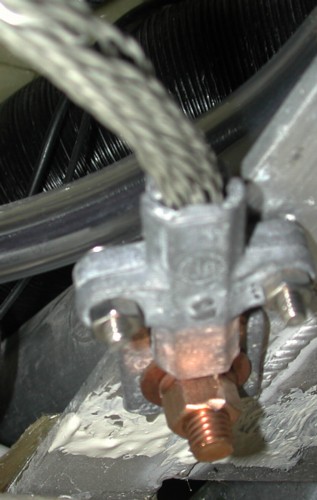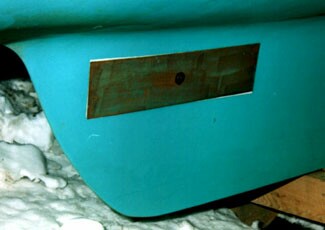Playing with Lightning
 As our Prout Escale was delivered in an unbonded, non-lighting protected state and since we are contemplating the use of the boat in Florida waters, we elected to install a series of ground plates in the hulls to hopefully dissipate lightning strikes. Our main conductor is the aluminum mast and the space frame supporting it underneath the deck. As there is a good contact between the two, we will attach the ground lead to the space frame instead of the mast itself. That saves us another hull penetration and the bolts should be big and conductive enough...
As our Prout Escale was delivered in an unbonded, non-lighting protected state and since we are contemplating the use of the boat in Florida waters, we elected to install a series of ground plates in the hulls to hopefully dissipate lightning strikes. Our main conductor is the aluminum mast and the space frame supporting it underneath the deck. As there is a good contact between the two, we will attach the ground lead to the space frame instead of the mast itself. That saves us another hull penetration and the bolts should be big and conductive enough...
The only initial snag was the difficulty finding the right conductor - i.e. one with strands thick enough. Normal wiring is much too fine and won't do. But after a short search on the internet, I found a company that not only had the conductors but the connectors that would allow us to interface the tinned copper conductors to the mast space-frame which is made of Aluminum.
To the right you can see the connection to the space-frame inside the starboard bathroom. Granted, the connection could be in better focus, but you get the idea. From here, the conductor gently slopes into the bilge and right up to the terminal of the bonding plate (see below).

One of two grounding plates, after the first season. Note the slight tilt induced during mounting... Sikaflex keeps the water out.
The grounding plates were acquired at West Marine, along with the Forespar lightning protector. This device is supposed to bleed of the charges that can attract lightning. If we are unfortunate enough to get hit, we hope that our system will minimize the damage. However, tying all the exposed metal pieces on the boat together will be a daunting challenge. So much is hidden behind wood or fake leather... on the other hand, the foam backing for the vinyl used by Prout Catamarans seems to be prone to break down after 10 years. Thus, as we remove and replace foamed vinyl sections in the coming years, upgrading the electrical system may be a "free" bonus.
Furthermore, the Perkins engine we use is not designed to be permanently bonded into a system. Among other things, there are no zincs in the heat exchanger because the design philosophy apparently was that the engine would only be grounded through a relay during operation. At all other times, the lack of a path was supposed to deter the deterioration of the heat exchanger. Only time will tell if this was a wise decision.
Best Estimate for Time Required:
| Find, buy parts | 5 hours |
|---|---|
| Drill holes in hulls, install plates w/Sikaflex, bolts | 4 hours |
| Create mast head bracket, install Lightning Preventer | 5 hours |
| Connect mast support to ground plates | 4 hours |
| "Test" system | 1 hour |
| Total | 19 hours |
|---|


